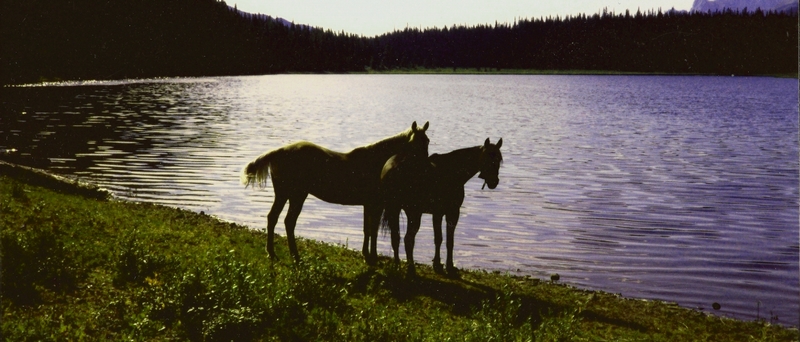Carbohydrate overload can be one of the major triggers for equine laminitis. This is when a horse’s digestive tract is too overwhelmed to process an excessive amount of sugary equine feeds, grain or high sugar load grasses, correctly. This can spur a sudden imbalance in bacteria & PH levels, leading to a toxic reaction that compromises circulation and blood pressure to the horse’s extremities, especially to his feet. And, this can be a precursor to laminitis. Laminitis is one of the most serious horse health issues known and horse owners should endeavor to prevent it.
While inferior horse nutrition is responsible for most cases of laminitis, there are, of course, many other causes. The 2006 Kentucky Derby winner, Barbaro, shattered his leg during a false start at that year’s Preakness. As so often happens with injured horses, Barbaro ultimately fell victim to laminitis. Horses are well designed for their role as prey animals. They spend most of their time standing, so as to be able to run off at the first sign of danger. A horse with an injured limb will still try to spend as much time standing as possible, compensating for the injury by trying to shift more weight onto its other limbs. This strategy is usually successful for only so long, given that horses already place 60% of their weight onto their front legs. The additional weight ultimately stresses the hoof’s laminae, spearheading a laminitis attack. If the laminitis isn’t treated by a vet almost immediately, it will, in many cases progress to the crippling condition known as founder.
By adjusting your horse feed, you can dramatically improve your horse’s chances of avoiding laminitis. Pasture lands with especially sugar rich grasses should be avoided. These high soluble carbohydrate grasses tend to grow mostly in Spring and Autumn. And, never let a horse gain access to the feed-bins or tack rooms where your grains, horse treats and specialty feeds are stored.
There aren’t many horses, who, given the opportunity, wouldn’t stuff themselves silly on sweet feed & grain. Unfortunately, all it takes is one incident of a horse breaking into a grain room, for the worst to occur. Regulating the temperature of your horse’s water is also very important. A horse will let itself become seriously dehydrated when confronted with water that’s too hot or cold. Then, forced by thirst, it may then gulp down large quantities of freezing or heated water. This can easily trigger a bout of laminitis or equine colic, so, be vigilant about both these issues.
The line between a horse turning into a butterball and looking sleek can be pretty fine. But, since fat horses are far more prone to laminitis, it’s up to you to keep your horse’s weight on the right side of the scale. If your horse gets fat, ask your vet’s advice on the best combo of horse grain,
horse supplements and hay to bring your horse’s weight down. Use the horse products she recommends and keep to the plan.
Peritonitis, (where the thin tissue that lines a horse’s abdominal walls gets irritated or inflamed), diarrhea in horses and metritis (where a mare’s uterine lining has become inflamed) are all capable of driving toxins into a horse’s system, creating a catalyst for laminitis. Call your vet immediately should any of these conditions arise.
The excessive surface shock creating by trotting and cantering horses on hard trails and pavement can make cart & driving horses particularly vulnerable to laminitis. Try never to go faster than a walk, outside of the ring. Discuss pads with your shoer and never let your horse’s feet grow too long.
Stress can trigger health problems in humans. It can also trigger horse health problems like laminitis. You know and love your horse. If he seems to be upset, you may need to consult your veterinarian to understand and fix, the problem.
Upon reviewing horse feed brands, never forget to consider your horse’s overall health. Discuss horse feed choices with your trainer and veterinarian. Horse nutrition, done right, can make a tremendous difference in your horse’s longevity. Research the horse supplement and equine feed products you’re considering very carefully before feeding your horse. Horse health is worth learning as much as possible, about.
Your horse’s digestive enzyme levels can play a key role in helping him avoid laminitis. If he’s on painkillers and taking anti-ulcer meds, make sure he’s monitored so that these products aren’t allowed to destroy his digestive enzyme balance. Without the right internal flora, his intestinal walls could become compromised, allowing blood toxins to flourish, impeding circulation and potentially triggering a laminitis episode.

Many people think you have to feed for horses with laminitis by practically starving the horse. Consult your vet about this. Most laminitis survivors do best on vitamins, minerals and forage feeds, in the right ratios. Alfalfa Hay and Straw Chaff may be recommended to help keep calcium levels up to par.
High fiber, low carbohydrate diets, balanced with equine supplements, should be the mainstay of virtually all horses, recuperating, competing or being used for pleasure. Senior horse feed is often recommended for older horses. While it’s a good idea to study up on horse feed, at the end of the day, you should always consult with your veterinarian about your horse’s diet, right down to the horse treats you select. Feeding horses that have experienced laminitis, the best possible diet, isn’t easy to do. There are so many supplements for horses and specialty feeds, it’s always recommended that you discuss your selections with the horse vet you trust most.


